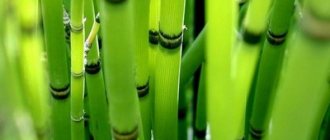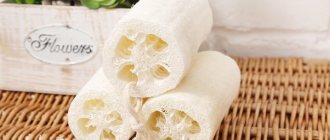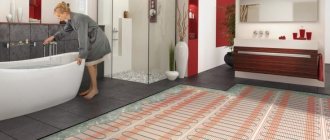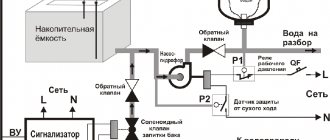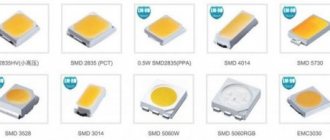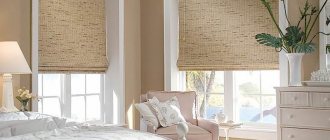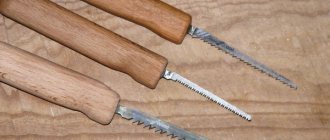In all types of repair and construction work, in the finishing of various premises, in the production of furniture and other structures, various types of self-tapping screws are widely used. The article will tell you how wood screws differ from other types and what sizes they come in.
A self-tapping screw is a universal fastening element in the form of a metal rod with a head and an external thread. When screwed into the materials being fastened, the sharp edge of the threaded spiral independently forms an internal thread in the material, which ensures a reliable connection. There are several types of self-tapping screws, the choice depends on the specific purpose. The main parameters by which this type of fastener is distinguished are manufacturing technology (determines corrosion resistance), pitch of the threaded spiral (different for different materials) and size.
Advantages and disadvantages of wood screws
Self-tapping screws appeared in Russia back in the sixties of the 20th century; the classic bolt was taken as the basis. However, if you look closely, its thread covers the entire surface of the rod, while the self-tapping screw does not. And the material used for the improved fasteners is more durable.
There are types of self-tapping screws that are used when working with materials of different densities, such as metal, plastic, and wood. Sometimes these fasteners are also called “hardware,” short for “metal product.” If we talk about the advantages of such fasteners, they are obvious: High strength and rigidity of the connection. Reusable. Adjustment of the required screw-in depth.
You can do without electricity, because you can screw in a self-tapping screw with a simple Phillips screwdriver. Versatility. There is no need to use additional elements (washers, gaskets). High speed of work completion. The only drawback is considered to be some fragility of the screws (hardened steel becomes brittle over time). The fastener, especially with a phosphated coating, can burst under even slight force. And this cannot be seen from the outside. Unlike self-tapping screws, nails do not have such a hidden defect.
Advantages of self-tapping screws for woodworking
To create an extremely durable, reliable structure of any length and weight, it is imperative to select the highest quality elements, and, of course, material. Most objects made from solid wood are assembled using self-tapping screws.
There are also many different types that are used for any specific task. However, they all have a wide range of technical advantages, due to which they are widely used:
- Such hardware allows you to form a reliable threaded hole, which ensures the strength of the created structure. Nails - their direct competitors - are not suitable for this, therefore, unlike self-tapping screws, they are used to solve a limited number of problems;
- The following advantage combines the previous aspect. Hardware for wood is characterized by versatility of use;
- self-tapping screws have a wide number of thread options to solve certain problems;
- there is a special cutter at the ends, which creates a hole with additional drilling without disintegrating the wood;
- the simple design significantly improves the efficiency of installation work. You won't hit your finger with a hammer like you would with nails;
- accelerated installation.
However, in addition to the advantages, there are also disadvantages. It involves using a hammer drill or drill. These products must have a built-in speed and torque control system, otherwise the hardware will crack and fall apart. But you can twist the screws with a screwdriver, but then be prepared for the fact that you will have to spend a lot of time.
Some types of self-tapping screws, such as confirmatory screws, require preliminary preparation of the hole. However, this disadvantage is offset by the quality of the connection, which is ensured by the use of hardware.
Classification of wood screws
A great variety of self-tapping screws have been invented: for metal, for wood, for roofing, for working with drywall, gypsum plasterboard, plastic, etc. But even in one subgroup they may differ. For example, there are several types of hardware for working with wood:
- Black oxidized - designed for use in light conditions.
- Yellow and white. They differ from their black counterparts in having more frequent threads, their angle of inclination (45 degrees) and a protective coating that gives them a yellowish or white color. Used for working with hardwood or chipboard.
- Wood grouse self-tapping screws - they are distinguished by more solid dimensions and a turnkey hex head. As a rule, they are used when assembling furniture.
It is believed that the oxidized coating of the black self-tapping screw imposes some restrictions on its use - only in dry places. Yellow and white screws, according to manufacturers, are more attractive in appearance, and the zinc coating provides reliable protection. In fact, black self-tapping screws are more popular among craftsmen. And it’s not just about the price (yellow or white fasteners are 20 percent more expensive).
As practice shows, yellow self-tapping screws are not much longer than black ones in terms of service life. And finer threads do not always provide reliable fixation of workpieces. But if the design of the product is of primary importance, it is better to use yellow or white fasteners - their appearance is more aesthetic.
How to choose wood screws
You should not use metal or universal screws to fasten wood. Universal ones are good when you need to twist wood and metal. And when twisting two pieces of wood, they work worse. In the sense that specialized fasteners will hold the wood better. That is, we consider only wood screws. Believe me, there will be plenty to choose from.
Self-tapping screws for wood are better yellow (yes, expensive) or white (a little cheaper)
As already said, wood screws have a rarer thread with a higher profile (the grooves between the turns are deeper). They are used not only for wood, but also for all types of sheet materials: gypsum fiber board, plywood, OSB (OSB), fiberboard and chipboard. Now about when which ones work better.
Carving and other bells and whistles
First you need to choose the type of hat. Countersunk or with a press washer, cylindrical, hemispherical - choose based on what kind of connection you need to make. It is also recommended to choose a TORX type slot, as it best transmits torque from the power tool. Next in order.
- You need to decide whether the thread should be applied to the entire rod or not. If you need to fasten two pieces of wood and pull them tightly together, use a self-tapping screw with an incomplete thread. This means that there should be an area without threads under the cap. The length is equal to the thickness of the attached part or slightly more. Due to this zone, “attraction” of one part to another occurs. How to choose wood screws: a few tips for fast and high-quality work
- To make screwing into hardwood or sheet material easier, there are wood screws with a router or mill. The cutter is only available on self-tapping screws with incomplete threads. It looks like several screw-type notches that are applied before starting the carving. The notches soften the wood, after which the self-tapping screw fits better.
- In general, wood screws have a thinner point and this prevents cracking of the wood. But there are also special “lotions” against cracking. These could be: grooves;
- cutting edges in the form of notches on the body of the screw;
- notches on several lower threads.
Are these bells and whistles necessary or is it a waste of money? As for the incomplete carving, this is not news. One part “fits” onto another much more tightly. And try the rest. Only from your own experience will you understand whether it works or not, and what exactly suits you best.
And practical advice on choosing wood screws. It is important that the thread goes straight from the very tip. If the first turn is too far or the tip is blunt, don’t take it. It will be pure torment, not work.
Application: useful tips
We hope that a small instruction on handling fasteners will be useful to the reader when assembling various wooden structures with his own hands.
- The 35mm wood self-tapping screw is ideal for attaching drywall to wood sheathing. Fastening elements are screwed in in increments of 15 - 20 cm after marking the position of the bars on the surface of the plasterboard; the heads are recessed into the drywall by about a millimeter and, when filling the seams, they are sealed with gypsum putty.
- Black wood screws 35 millimeters long are perfect for covering a wooden frame with plywood or OSB. The holes for them in the sheet material are pre-drilled with a diameter equal to the outer diameter of the fastener thread. Then the holes are countersunk with a drill whose diameter is equal to the size of the head.
- A 51 mm long wood self-tapping screw is suitable for two-layer plasterboard sheathing of a wooden partition frame when attaching the second layer. Double cladding is necessary in small rooms with high traffic.
- Wood screws 75 mm or longer in length cannot be screwed into wooden parts without first drilling holes 1 - 1.5 millimeters smaller in diameter. Otherwise, there is a risk of splitting the wood along the fibers.
- If you need to screw a wood screw 100 mm or longer into dense wood, pre-drilling may not be enough. The screwdriver simply will not be able to turn the hardware on the last turns. A simple trick will help here: drop a little of any oil (for sewing machines, mineral or even waste oil) into a pre-drilled hole.
- Plywood with a thickness of more than 15 mm can be joined end-to-end at right angles, without corners or bars; Moreover, such a connection will be noticeably stronger than using the same furniture corners. In the plane of one of the parts, holes are drilled equal to the diameter of the self-tapping screw; at the end of the second part - with a diameter of 1 - 1.5 mm less.
The size of the hardware depends on the thickness of the parts being connected: for 15 mm, 51 mm fasteners are suitable; A 75 mm long wood screw can be used with 22 mm plywood.
- To seal recessed caps on the front surfaces of parts, you can use acrylic wood putty; however, it is difficult to match it exactly to the wood. Another method is much more practical: mix the sawdust remaining after drilling with a small amount of PVA glue - and you will get a putty that, after the glue sets, will exactly match the color of the material.
Choice
What exactly is a self-tapping screw? Let's get a look:
Schematic representation of a self-tapping screw
| Designation in the figure | Item name |
| 1 | Head. It is the upper part of the fastener and tightens the connected elements; it can have different shapes. |
| 2 | External thread edge. Cuts internal threads in wood, increasing the reliability of fixation. |
| 3 | Tip. It enters the wood first, paving the way for the entire self-tapping screw. |
| 4 | Slot. A special cutout for a screwdriver or screwdriver attachment, which can have a cross-shaped hexagonal or square shape. |
These elements, including the composition of the metal from which the self-tapping screw is made, affect its characteristics, from which the following selection criteria can be distinguished:
Criterion #1: color
Yellow wood screws look great when attaching gold-plated hinges and door locks
The material used for making self-tapping screws can be brass, stainless or carbon steel. The last option has the lowest price, which is why it is the most popular.
Carbon steel hardware has a different protective coating, which can be easily identified by its color:
| Color | Type of protective treatment | Application area |
| Black | Oxidation | Rooms with normal humidity |
| Silver or gold | Galvanizing | Interior and exterior works |
Black wood screw has a somewhat limited area of use
Criterion No. 2: thread
The thread pitch can tell you which wood screws are best to use.
The following options are possible:
- Average. Such hardware is universal in use and the most popular, as it can be used for fastenings of any type.
Different sizes of yellow wood screws with medium thread pitch
- Frequent. Designed for connecting metal products.
Advice: do not use self-tapping screws with frequent thread pitches when working with wood. Such a fine thread will not catch on wood fibers, but will simply destroy them by drilling a hole.
Sample fastener with fine thread
- Rare. This hardware, unlike the previous option, on the contrary, has a weak drilling ability, but is capable of enveloping a large number of fibers with the edges of the thread, which makes it ideal for joining soft wood, plastic, gypsum or even asbestos.
Different sizes of black wood screws with a rare thread pitch
- Medium, herringbone profile. Used for fixing products to concrete surfaces by driving them into a dowel.
Herringbone self-tapping screw with plastic dowel
Tip: Don't try to screw a herringbone fastener into wood, as the tip is completely smooth and won't penetrate the grain.
- Asymmetrical. They require preliminary drilling, but are ideal for joining furniture pieces made of wood, chipboard and plywood.
Self-tapping screw with asymmetrical thread for assembling furniture interior items
Criterion No. 2: hat
The next important element when choosing suitable hardware is the head, with which we come into most contact during the work process, and it remains the only visible part of the screw.
The following varieties are observed here:
- Secret. Upon completion of tightening the fastener, the cap is completely hidden in the wood, without protruding from it.
Universal wood screws with countersunk head
- Semicircular. Provides strong grip due to a sufficiently large adhesion area.
Hemispherical cap sample
- Semicircular with press washer. They have a reduced height and increased contact area, which is ideal for fastening sheet materials.
Silver wood screw with press washer
- Small secret. Reducing the countersunk head and creating a smooth transition from it to the rod made it possible to apply much more effort when tightening the fastener.
- Semicircular with a large press washer. It copes well with fastening soft materials, reliably pressed by the enlarged contact plane.
Example of a wide press washer
- Hexagonal. A self-tapping screw with a hex head for wood can be tightened with more force using a special key than all other options. Because of this, I also call them “wood grouse”.
Self-tapping screws for wood have maximum fixation force
- Concealed with a slot for a hex key. It has the best camouflage effect and also makes it possible to cover the joint with a decorative cap.
Hexagon wood screws are perfectly camouflaged with the help of a special decorative plug
There is also a self-tapping hook for wood, which has a hook instead of a head.
State standards for wood screws
According to GOST parameters, wood screws received a certain marking - they correspond to a single standard number 1145. This GOST was adopted back in the 80s of the last century. It hasn't changed since then. In addition to the standard sizes that were mentioned above in the table, the standard determines the material from which the self-tapping screw is made. This steel is of three types: carbon, low-carbon and corrosion-resistant. The standards clearly standardize the fastener manufacturing process down to the size of its head and the applied coating. Thus, you can know exactly which screw is needed for certain purposes and buy it anywhere in our country.
Classification of self-tapping screws by type of thread pitch (RS)
It is worth noting that this property is one of the main ones. Depending on the type of thread, the specifics of using hardware for fastening are determined:
- wide RS - names with this property are used when working with soft materials, for example, plasterboard, chipboard, fiberboard, MDF or plastic;
- low RS – fasteners are used to work with dense materials, for example, metals, hardwoods, hard plastics;
- two-type thread is a distinctive feature of multifunctional products. Names with this type are used to provide connections between two materials with different densities. As a rule, such hardware is widely used for working with gypsum fiber sheets and metal profiles.
Often, to further expand the functionality, hardware is modernized by equipping it with special grooves, cutting edges, sawtooth turns or a milling cutter. All these elements allow you to simultaneously perform both installation and hole preparation.
Documents regulating the production of wood screws
The document regulating the production of wood screws is currently GOST 1145-80 (ST SEV 2327-80) “Screws with a countersunk head. Design and dimensions (with Changes No. 1, 2).” This document defines the geometric dimensions and shape of the head, the mass of the products and their quality characteristics, as well as the characteristics of the slot (number, radius, depth). In addition, GOST regulates the marking of self-tapping screws, which greatly simplifies the selection of the required fastening element from the catalog for specific use cases.
Selecting the length of screws
There are several rules for choosing the length of a self-tapping screw that apply in different situations. When uniting/connecting two not very massive parts, the following selection rules apply:
- Whatever you connect, the sharp end of the screw should not stick out from the other side of the parts being connected. That is, in any case, it should be shorter than the parts being connected. Moreover, it is believed that maximum strength will be if at least 5-6 mm remains to the edge of the lower part. So consider it. The length of the screw is selected depending on the parts being fastened
- On the other hand, the minimum self-tapping screw should enter the lower part by at least 1/3 of the thickness of the attached part. That is, if you are fastening, say, a 100*100 mm beam, then the minimum length of the screw should be 1/3 longer. For this beam, the minimum length of the self-tapping screw is 100 + 100/3 = 133 mm. Take the nearest larger one. If you are fastening a board 28 mm thick, then the minimum length of the screw is 28 +28/3 = 37 mm (usually 42 mm is chosen).
If some thin part is attached to a massive base, a different rule applies. Then the length of the fastener should be 2-2.5 times longer than the attached part. This is how you need to select the length of the screw if you are attaching something to a wall, say, or to a concrete floor. In this case, to fasten the same 28 mm board to the wall, the length of the fastener is 56-70 mm. That's the difference.
Self-tapping screw sizes: most applicable options
How to choose the length of the screws should be clear. Now about what they generally are. The situation here is confusing. Neither screws nor self-tapping screws have a common standard. There are several standards of “worn out” years of manufacture, which specify the dimensions of certain types of self-tapping screws.
- GOST 1145-80. Countersunk self-tapping screws.
- GOST 1144-80. Round head screws.
- GOST 1146-80. Screws with a semi-countersunk head.
The situation today is that each manufacturer produces its own “lines”. They focus, of course, on demand. Well, the parameters of the heads are usually made in accordance with one or another GOST. This will at least somehow stabilize the situation. Sometimes the assortment - diameters and lengths are also made according to the standard. In this case, in the description of the screws, the diameters in which they are generally produced are indicated, and then there is a postscript: it corresponds to such and such GOST. This means that the heads comply with the specified standard, and also that the assortment corresponds.
How then do you choose self-tapping screws according to length and diameter? Calculate/determine the length that is needed and determine the type of head. Then they look at the diameters and make the final choice. Let’s say right away that for wood the principle “thicker is better” does not work. This can be applied to metal. For wood, thinner ones are better, but with good carvings and made of good metal. This is the ideal option.
If the parameters of the screws are y, they are indicated in the description
But this is not enough. The store usually offers up to a dozen options of the same size, but from different manufacturers. And if it’s more or less easy to decide on the metal and type of processing, then choosing which brand to take is difficult. There are, of course, proven ones, but they are expensive. Although, if you take cheap ones, 30-50% may be wasted. What kind of marriage? Either they bend or the caps fly off. This is not always, but often. If you are “lucky” to come across such fasteners, it turns out that it would not be more expensive to buy “expensive” ones. Well, or not much more expensive.
Now compare the two tables. They are compiled according to different GOSTs. As you can see, the diameters and lengths are the same. This is what makes life easier. If during the production of fasteners we adhered to the standard in terms of the diameter/length ratio, then everything is simple. If not, then the manufacturer includes a table with dimensions in the description of the screws (as in the figure above).
